Study on the Separation Effect and Mechanism of 6–0.5 mm Coal in Fluidized Bed with Vibratory Combined Force Field
Abstract
:1. Introduction
2. Materials and Methods
2.1. Materials
2.2. Apparatus and Methods
2.2.1. Vibratory Combined Force Field Fluidized Bed
2.2.2. Evaluation Index
3. Results and Discussion
3.1. Vibration Characteristics and Air Velocity Distribution of the Fluidized Bed
3.2. Influence of Vibration on Density Spatial Distribution of Coal Particles
3.3. Influence of Air on Density Spatial Distribution of Coal Particles
3.4. Analysis of Separation Effect
4. Conclusions
- (1)
- The kinematic characteristics of the vibratory combined force field fluidized bed are analyzed. In the stable stage, the main vibration direction of the separator is the X-axis, and the maximum displacement amplitude can reach 6.88 mm and 3.78 mm along the X- and Z-axes, respectively. The velocity and acceleration are always the same in the X and Z directions. The velocity amplitudes were 287.60 mm/s and 161.6 mm/s, and the acceleration amplitudes were 10.43 m/s2 and 5.92 m/s2, respectively. The phase difference is 180° along the Y-axis.
- (2)
- The air velocity and distribution are not uniform under the load condition, which is specifically represented by the larger air velocity near the feeding end and the inclined side wall. The high air speed in the feeding area is conducive to fast loose material, which drives the material group to spread to the separation area. The gangue transport channel is near the right-side wall, and the high fluidizing air velocity is conducive to ensure the stable migration of high-density gangue particles. With the increase in air supply, the uniformity of air velocity distribution on the fluidized bed surface is improved.
- (3)
- The influence of vibration and airflow on coal particle spatial distribution is analyzed. The results show that under the synergistic effect of vibration and airflow, the stratification and separation of raw coal can be realized. With increasing frequency and airflow, the separation effect of particles on the fluidized bed is upgraded. The better longitudinal density stratification is realized under the larger air drag force. Different lateral migration effects are realized by the larger vibration, friction, and angle of bed, and the separation of particles are achieved.
- (4)
- For the 6–0.5 mm product, the maximum Sash is 1.896 under the frequency of vibration in 34 Hz and blower in 5.68 m/s. The clean coal yield of discharge ports from products 1–4 are 85.28% and ash content is 10.69%.
Author Contributions
Funding
Conflicts of Interest
References
- National Bureau of Statistics. Statistical Bulletin on National Economic and Social Development 2021. Available online: http://www.stats.gov.cn/tjsj/zxfb/202202/t20220227_1827960.html (accessed on 6 June 2022).
- National Development and Reform Commission. Increasing the Release of High-Quality Coal Production Capacity, Ensuring Coal Supply and Keeping Prices Stable. Available online: https://www.ndrc.gov.cn/fzggw/jgsj/yxj/sjdt/202203/t20220309_1318838.html (accessed on 7 June 2022).
- Xue, Y.; Wang, H.; Tang, J.; Fan, J. Report of Mineral Resources Conservation and Comprehensive Utilization in China (2015). China Land Resour. Econ. 2016, 29, 2. [Google Scholar]
- Xie, K. Research on the Strategy of Clean, Efficient and Sustainable Development and Utilization of Coal in China; Science Press: Beijing, China, 2014. [Google Scholar]
- Zhang, P. Discussion of the application of heavy media shallow tank separation machine and its failure treatment in coal processing plant. Coal Chem. Ind. 2021, 44, 123–126. [Google Scholar]
- Gao, Z.; Chai, X.; Zhou, E.; Jia, Y.; Duan, C.; Tang, L. Effect of the distributor plugging ways on fluidization quality and particle stratification in air dense medium fluidized bed. Int. J. Min. Sci. Technol. 2022, 30, 883–888. [Google Scholar] [CrossRef]
- Zheng, G. Slime heavy medium cyclone advantages in coal production. Filtr. Separat. 2016, 53, 40–45. [Google Scholar]
- Bu, X.; Wang, X.; Zhou, S.; Li, B.; Zhan, H.; Xie, G. Discrimination of Six Flotation Kinetic Models Used in the Conventional Flotation and Carrier Flotation of-74 mu m Coal Fines. Acs Omega 2020, 5, 13813–13821. [Google Scholar] [CrossRef] [PubMed]
- Hu, H.; Li, M.; Li, L.; Tao, X. Improving bubble-particle attachment during the flotation of low rank coal by surface modification. Int. J. Min. Sci. Technol. 2020, 30, 217–223. [Google Scholar] [CrossRef]
- Sokolovic, J.; Miskovic, S. The effect of particle size on coal flotation kinetics: A review. Phys. Probl. Mi. 2018, 54, 1172–1190. [Google Scholar]
- Luo, Z.; Zhao, Y.; Yu, X.; Duan, C.; Song, S.; Yang, X. Effects of characteristics of clapboard unit on separation of <6 mm fine coal in a compound dry separator. Powder Technol. 2017, 321, 232–241. [Google Scholar]
- Qiao, J.; Wen, P.; Duan, C.; Wang, W. Particle behavior and parameter optimization in treatment of waste petroleum reforming catalysts based on a compound dry separator. Adv. Powder Technol. 2020, 31, 1181–1195. [Google Scholar] [CrossRef]
- Yu, X.; Luo, Z.; Li, H.; Gan, D. The diffusion process of the dense medium and its effects on the beneficiation of 0-6 mm oil shale in the continuous vibrating air dense medium fluidized bed. Fuel 2018, 234, 371–383. [Google Scholar] [CrossRef]
- Oshitani, J.; Sasaki, T.; Tsuji, T.; Harada, S.; Kajiwara, H.; Matsuoka, K. Unstable sinking of spheres at higher air velocity in a gas-solid fluidized bed. Adv. Powder Technol. 2021, 32, 1300–1304. [Google Scholar] [CrossRef]
- Chalavadi, G.; Singh, R.K.; Sharma, M.; Singh, R.; Das, A. Development of a Generalized Strategy for Dry Beneficiation of Fine Coal over a Vibrating Inclined Deck. Int. J. Coal Prep. Util. 2016, 36, 10–27. [Google Scholar] [CrossRef]
- Song, J.; Hu, B.; Jia, J.; Zhang, H.; Yue, S. Exploratory and experimental study on upgrading of coal-series Kaolin through decarbonization using pneumatic separation method. Coal Prep. Technol. 2019, 06, 39–42. [Google Scholar]
- Ku, J.; Lei, Z.; Xia, J.; Guo, B.; Chen, H.; Peng, X.; Ran, H.; Deng, R. Dynamic behavior and separation prediction of magnetic ore bulks in dry medium-intensity magnetic separator. Min. Eng. 2021, 171, 107113. [Google Scholar] [CrossRef]
- Yuan, Z.; Zhao, X.; Lu, J.; Lv, H.; Li, L. Innovative pre-concentration technology for recovering ultrafine ilmenite using superconducting high gradient magnetic separator. Int. J. Min. Sci. Technol. 2021, 31, 1043–1052. [Google Scholar] [CrossRef]
- Zhang, M.; Guo, X.; Ren, W.; Dai, S. Mechanical characteristics of magnetite as a function of particle size during column-based magnetic separation. Sep. Sci. Technol. 2022, 57, 1175–1185. [Google Scholar] [CrossRef]
- Li, C.; Zhang, X.; Li, H.; Wen, X.; Zheng, C. Influence of particle size range on coal fly ash triboelectrostatic separation. Energy Sources. Part A Recovery Util. Environ. Eff. 2021; ahead-of-print. [Google Scholar] [CrossRef]
- He, X.; Sun, H.; Wang, W.; Zhang, X. Predictions of triboelectrostatic separation of minerals in low-rank coal based on surface charging characteristics in relation to their structures. Fuel 2020, 264, 116824. [Google Scholar] [CrossRef]
- Wang, H.; Ma, Z. Application of image processing and recognition technology in automatic separation system of coal gangue. Electron. Test 2021, 13, 112–113+83. [Google Scholar]
- Gao, X. Design of Intelligent Separation System for Coal and Gangue Based on Machine Vision. Doctoral Dissertation, Taiyuan University of Technology, Taiyuan, China, 2021. [Google Scholar]
- Zhang, Y.; Zhu, H.; Zhu, J.; Ou, Z.; Shen, T.; Sun, J.; Feng, A. Experimental study on separation of lumpish coal and gangue using X-ray. Energy Sources. Part A Recovery Util. Environ. Eff. 2021; ahead-of-print. [Google Scholar] [CrossRef]
- Li, G.; Klein, B.; Sun, C.; Kou, J. Lab-scale error analysis on X-ray fluorecence sensing for bulk ore sorting. Min. Eng 2021, 164, 106812. [Google Scholar] [CrossRef]
- Zhao, Y.; Zhang, Y.; Zhou, E.; Zhou, C.; Dong, L.; Zhang, B.; Duan, C. Research progress and prospect of clean and efficient dry coal separation. J. China Univ. Min. Technol. 2022, 51, 607–616. [Google Scholar]
- He, J.; Chen, H.; Zhu, L.; Tan, M.; Liu, B.; Chen, L.; Zhang, M. Decarbonization and upgrading of fine-sized coal-series kaolinite via the enhancement of density stability and uniformity of dense-phase gas-solid fluidized bed. Powder Technol. 2021, 394, 62–72. [Google Scholar] [CrossRef]
- Yu, X.; Luo, Z. Effect of 0–1 mm pulverized coal on desulfurization and upgrading of low grade lignite in dry cascade separation bed with compound force field. Fuel 2022, 309, 122116. [Google Scholar] [CrossRef]
- Fan, X.; Zhou, C. Estimation of Bed Expansion and Separation Density of Gas–Solid Separation Fluidized Beds Using a Micron-Sized-Particle-Dense Medium. Separations 2021, 8, 242. [Google Scholar] [CrossRef]
- Liu, C.; Wang, Q. New Approach Study on Dry Coal Cleaning System with Two-Stage Corona Electrostatic Processes for High-Sulfur Low-Grade Fine Coals. Processes 2021, 9, 1915. [Google Scholar] [CrossRef]
- Fan, X.; Ren, Y.; Dong, L.; Zhou, C.; Zhao, Y. Optimization of coal size for beneficiation efficiency promotion in gas-solid fluidized bed. Part. Sci. Technol. 2022; ahead-of-print. [Google Scholar] [CrossRef]
- Guo, M.; Zhao, Y.; Guo, J.; Byambajav, E.; Yan, G.; Zhang, Z.; Zhao, P.; Ni, Z.; Zhang, B. Removal behavior and mechanism of AAEMs and Fe in Zhundong coal under acidic ionic liquid system. Fuel 2022, 320, 123997. [Google Scholar] [CrossRef]
- Li, G.; Wang, D.; Liu, Q.; Zhao, Y.; Duan, C. Separation performance of 0.5–1 mm fine coal in a gas-solid fluidized bed without dense medium. Fuel 2022, 318, 123645. [Google Scholar] [CrossRef]
- Yu, X.; Luo, Z.; Li, H.; Yang, X.; Zhou, E.; Jiang, H.; Wu, J.; Song, S.; Cai, L. Effect of vibration on the separation efficiency of high-sulfur coal in a compound dry separator. Int. J. Miner. Process. 2016, 157, 195–204. [Google Scholar] [CrossRef]
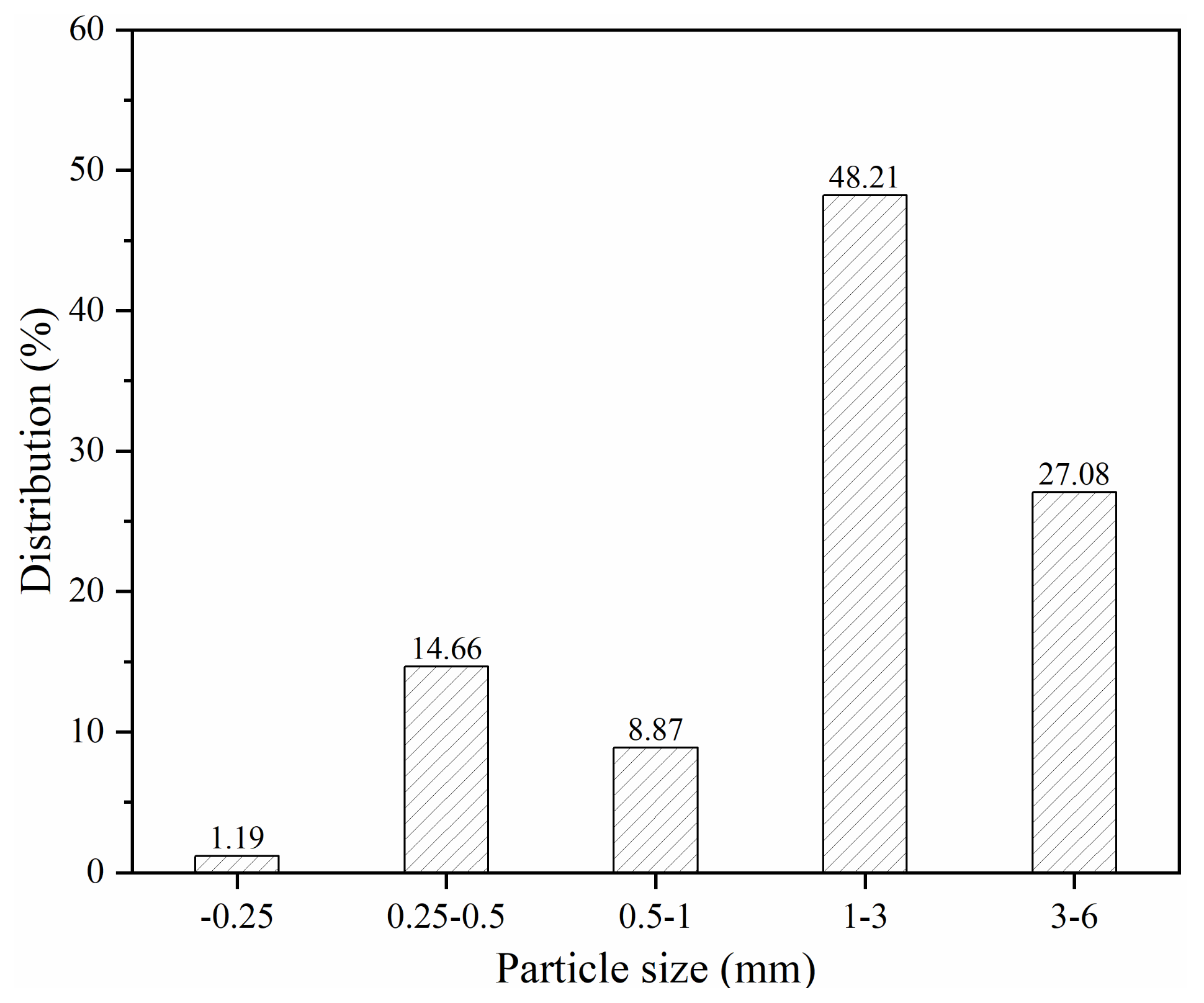
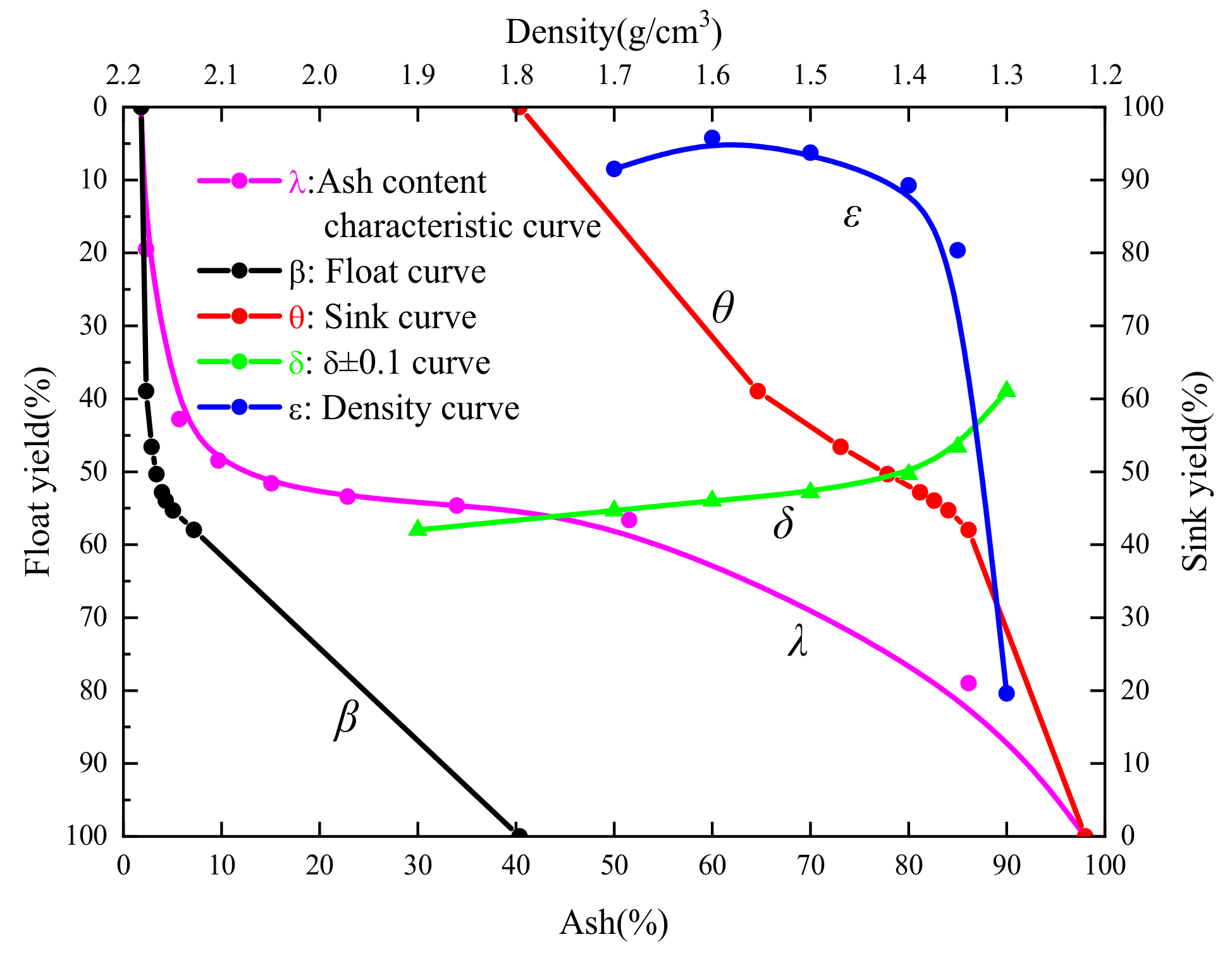


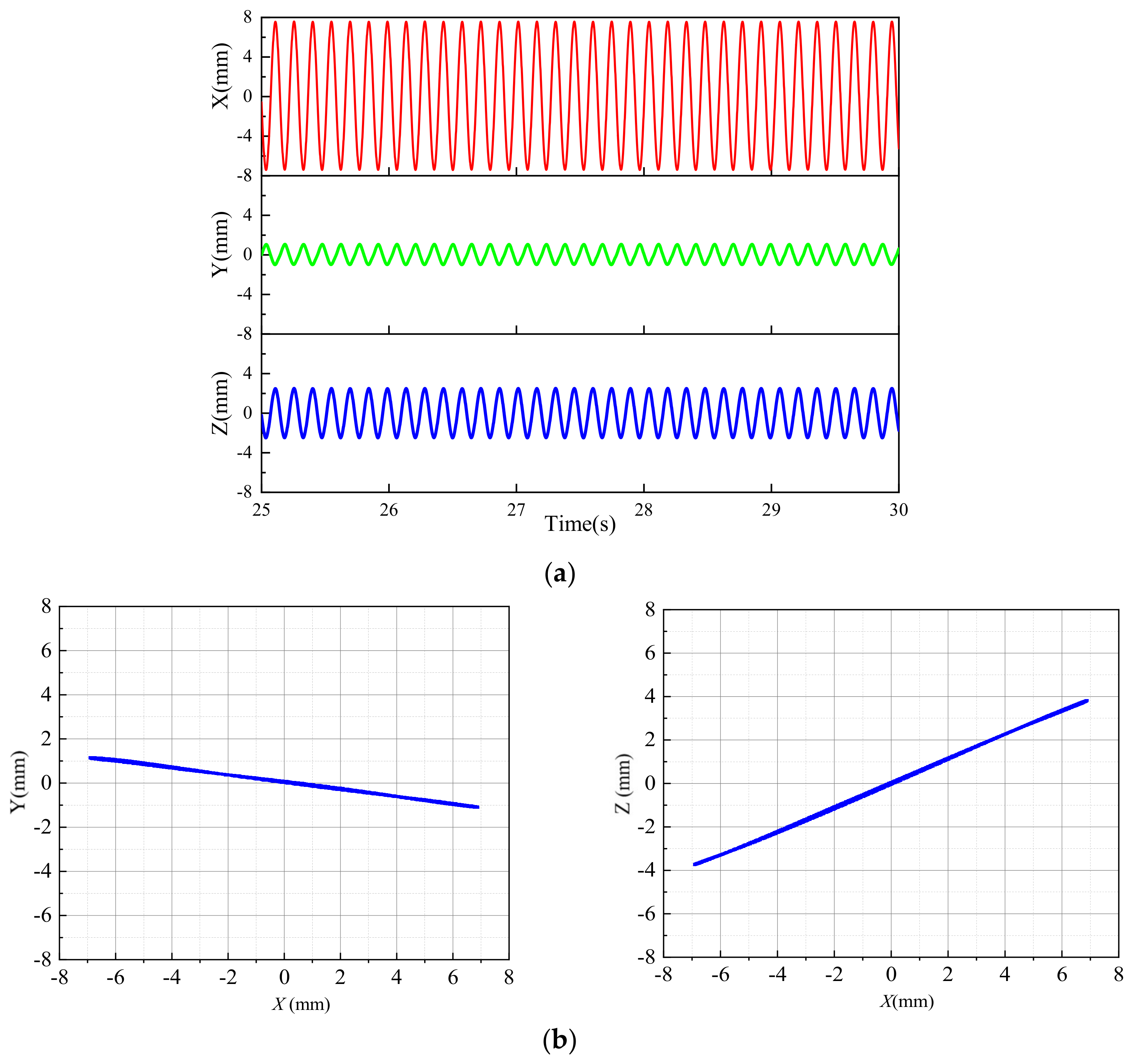
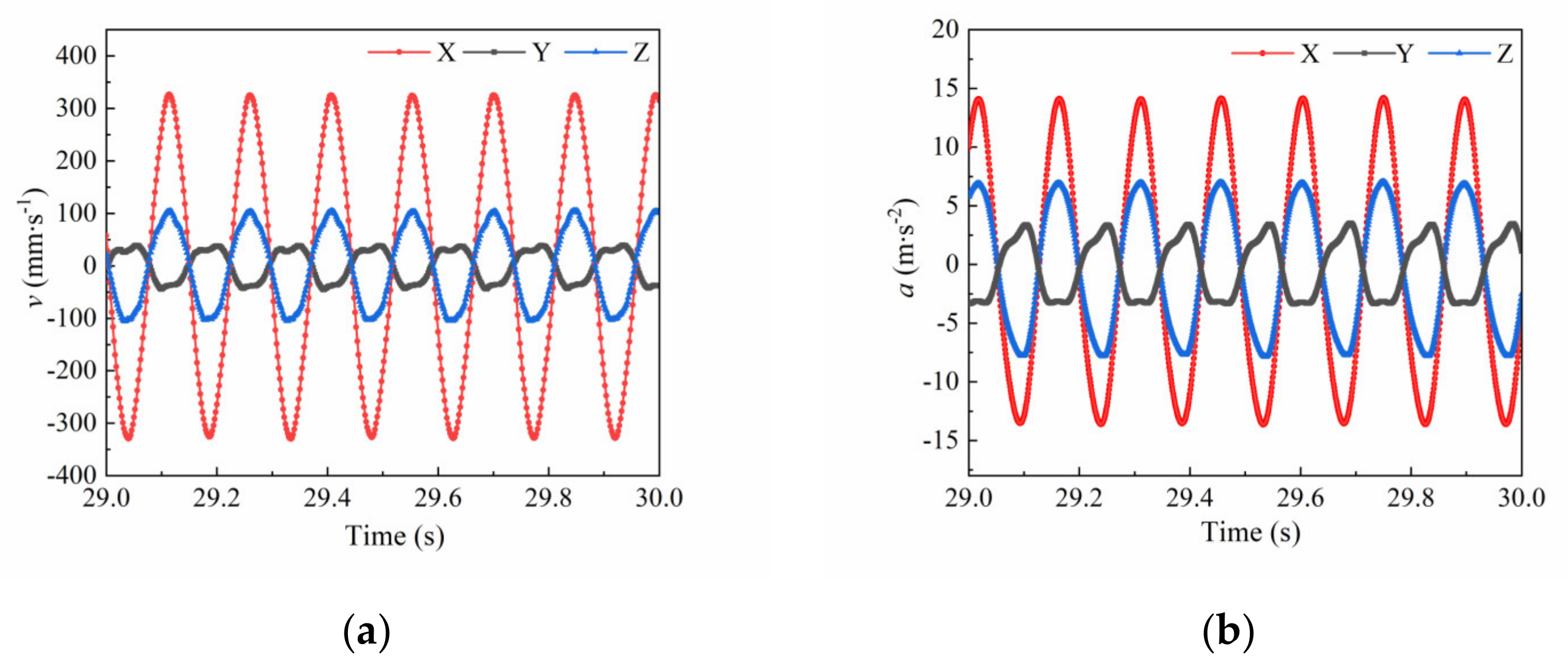


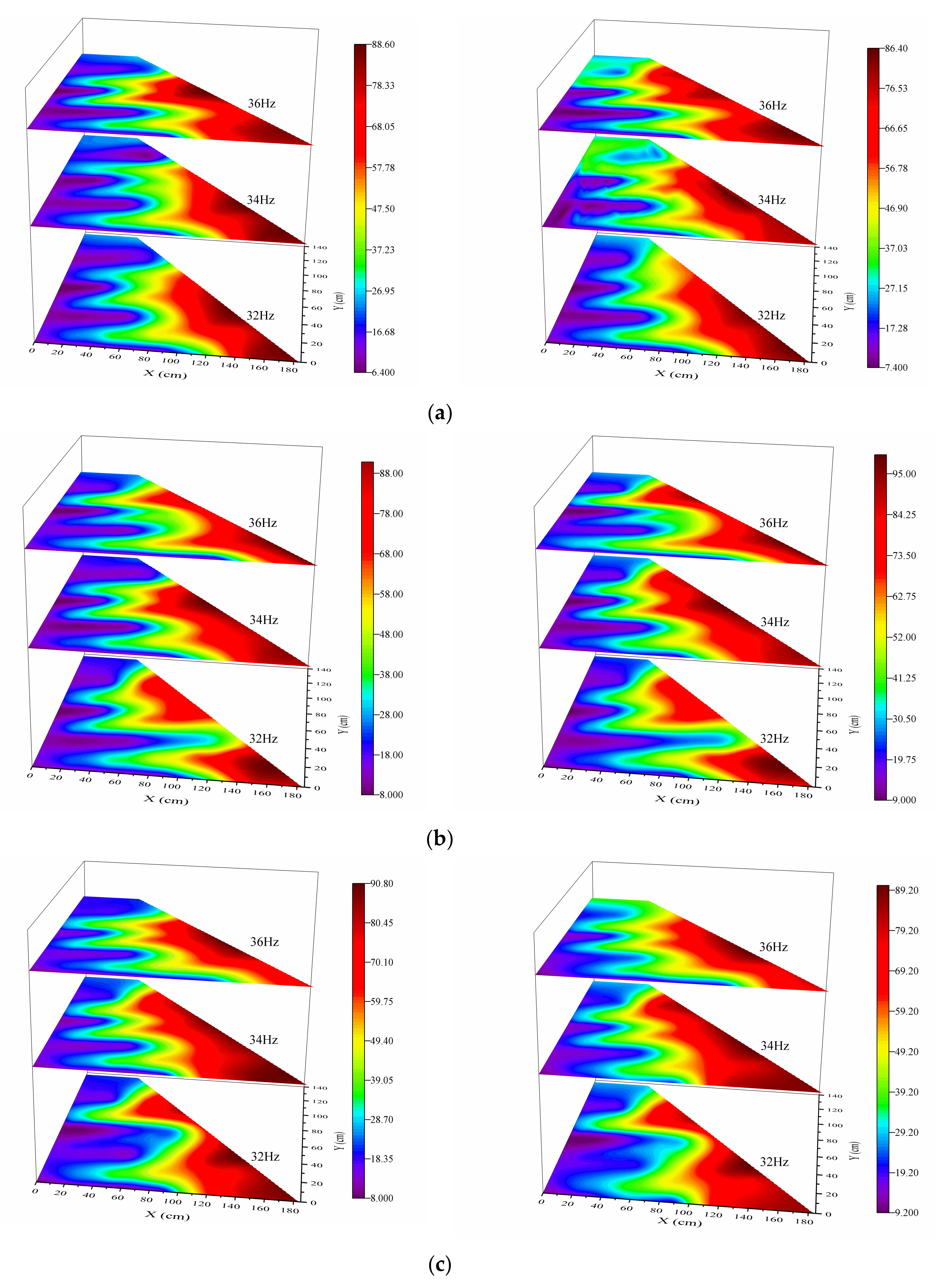
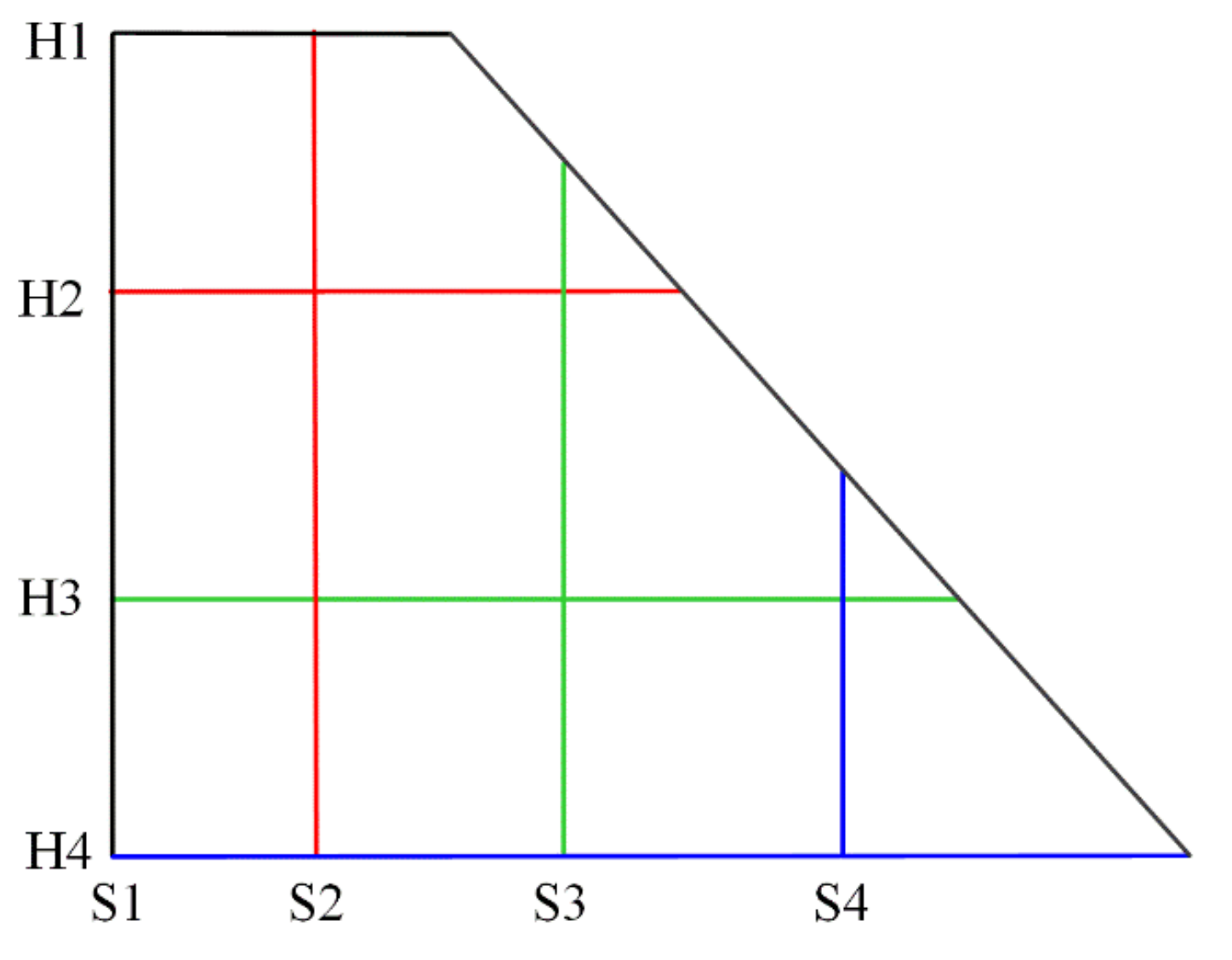
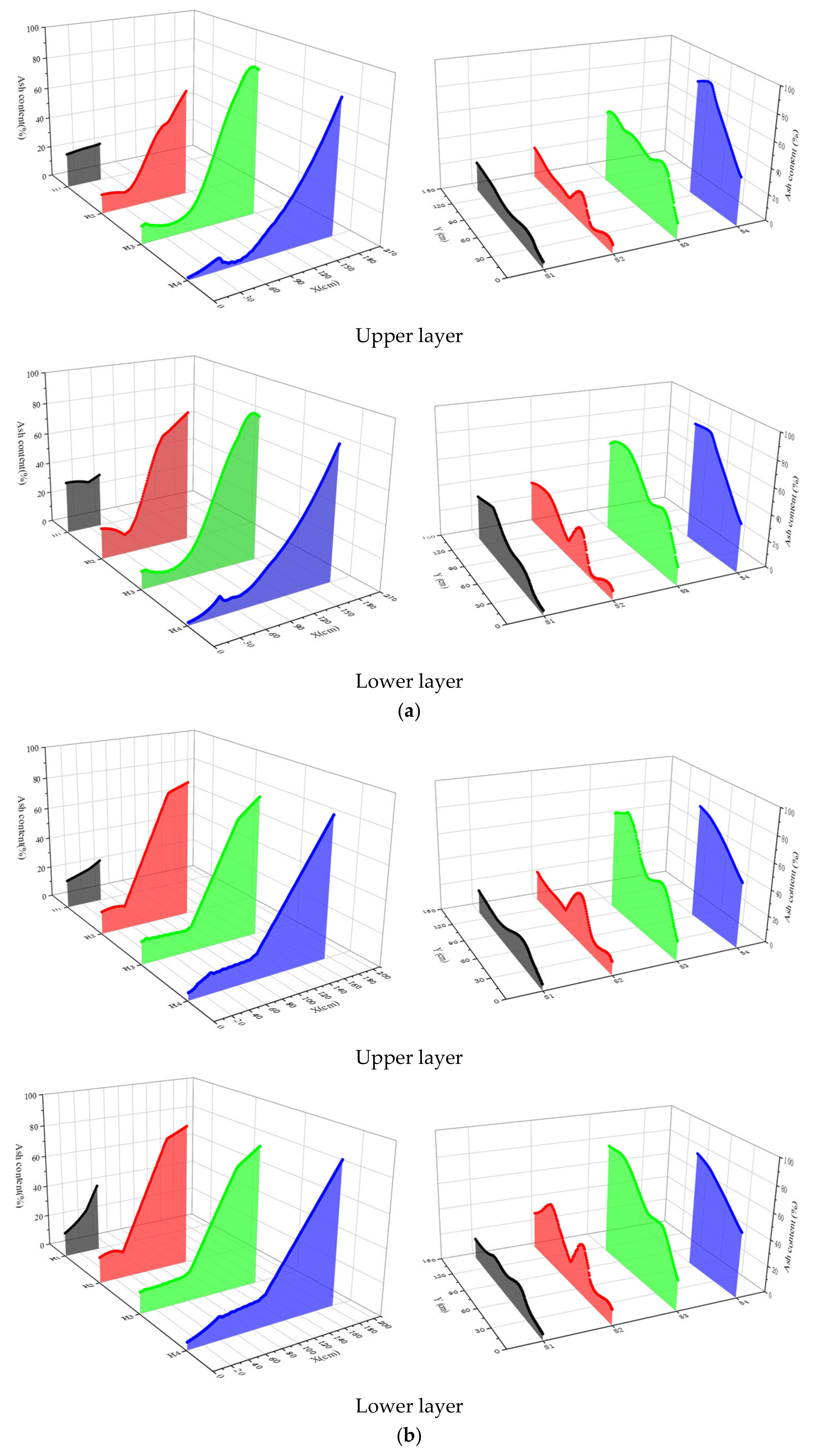

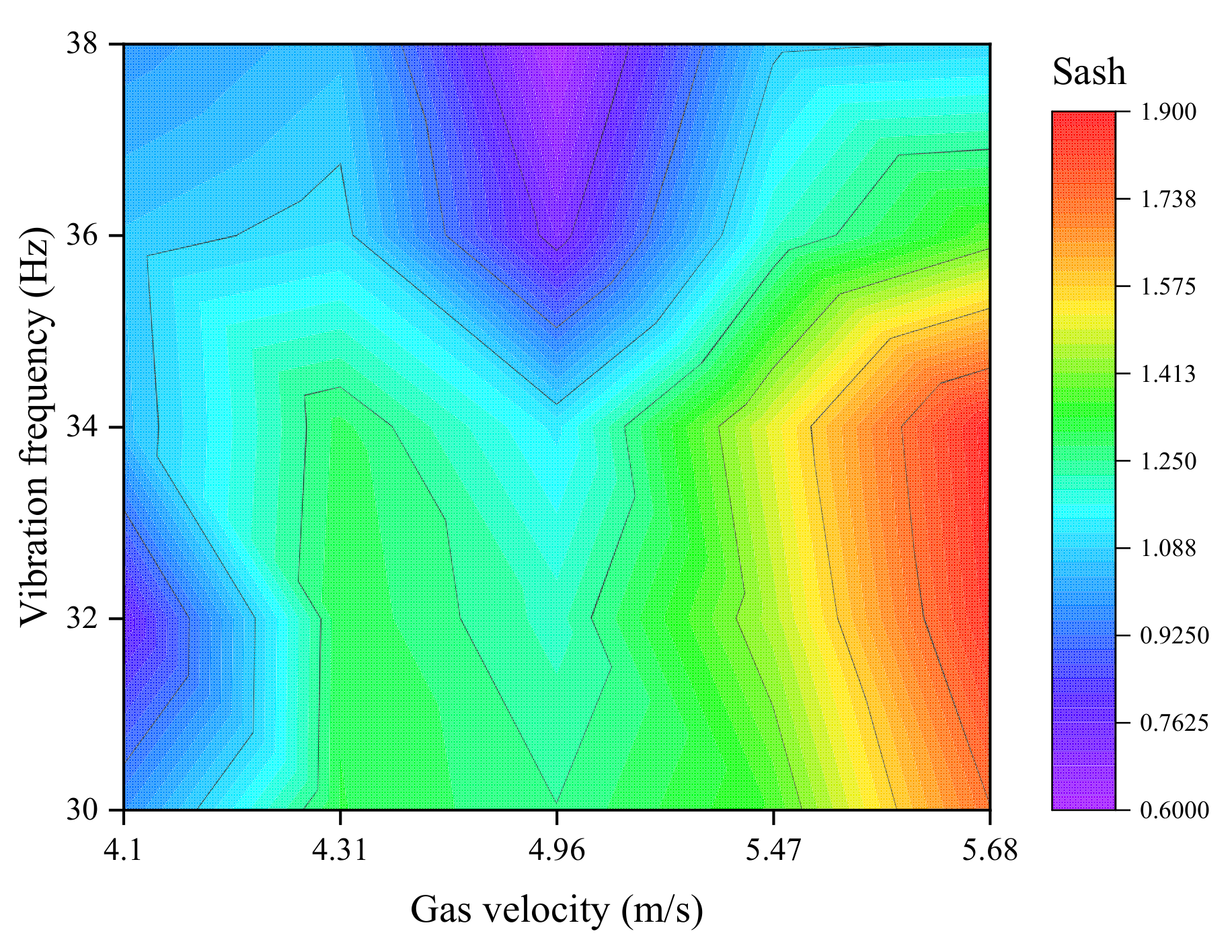
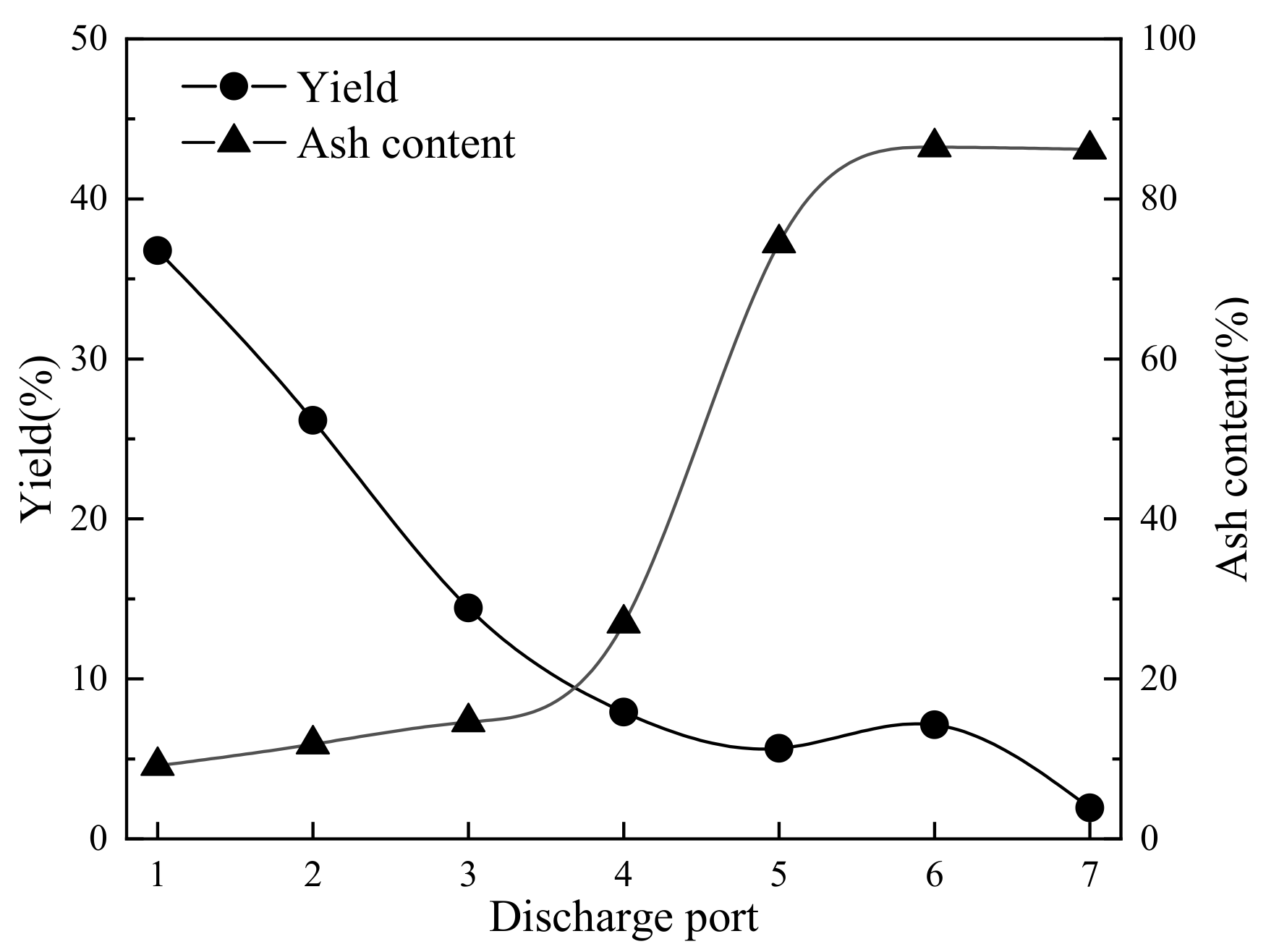
| Density (g/cm3) | Yield (%) | Ash Content (%) | Cumulative Floats | Cumulative Sinks | Separating Density | |||
|---|---|---|---|---|---|---|---|---|
| Yield (%) | Ash Content (%) | Yield (%) | Ash Content (%) | Density (g/cm3) | Yield (%) | |||
| –1.3 | 47.41 | 4.77 | 47.41 | 4.77 | 100.00 | 38.04 | 1.3 | 54.11 |
| 1.3–1.4 | 6.70 | 12.18 | 54.11 | 5.69 | 52.59 | 68.03 | 1.4 | 8.84 |
| 1.4–1.5 | 2.14 | 22.05 | 56.25 | 6.31 | 45.89 | 76.18 | 1.5 | 3.29 |
| 1.5–1.6 | 1.15 | 30.69 | 57.40 | 6.80 | 43.75 | 78.83 | 1.6 | 3.17 |
| 1.6–1.7 | 2.02 | 40.95 | 59.42 | 7.96 | 42.60 | 80.13 | 1.7 | 3.45 |
| 1.7–1.8 | 1.43 | 48.23 | 60.85 | 8.91 | 40.58 | 82.08 | 1.8 | 2.27 |
| 1.8–1.9 | 0.84 | 54.24 | 61.69 | 9.52 | 39.15 | 83.32 | 1.9 | 0.84 |
| +1.9 | 38.31 | 83.96 | 100.00 | 38.04 | 38.31 | 83.96 | - | - |
| Total | 100 | 38.04 | - | - | - | - | - | - |
Disclaimer/Publisher’s Note: The statements, opinions and data contained in all publications are solely those of the individual author(s) and contributor(s) and not of MDPI and/or the editor(s). MDPI and/or the editor(s) disclaim responsibility for any injury to people or property resulting from any ideas, methods, instructions or products referred to in the content. |
© 2023 by the authors. Licensee MDPI, Basel, Switzerland. This article is an open access article distributed under the terms and conditions of the Creative Commons Attribution (CC BY) license (https://creativecommons.org/licenses/by/4.0/).
Share and Cite
Yang, F.; Zhang, M.; Ren, G.; Yao, S.; Zhou, E. Study on the Separation Effect and Mechanism of 6–0.5 mm Coal in Fluidized Bed with Vibratory Combined Force Field. Energies 2023, 16, 1133. https://doi.org/10.3390/en16031133
Yang F, Zhang M, Ren G, Yao S, Zhou E. Study on the Separation Effect and Mechanism of 6–0.5 mm Coal in Fluidized Bed with Vibratory Combined Force Field. Energies. 2023; 16(3):1133. https://doi.org/10.3390/en16031133
Chicago/Turabian StyleYang, Fan, Mingrui Zhang, Guangjian Ren, Shaoyu Yao, and Enhui Zhou. 2023. "Study on the Separation Effect and Mechanism of 6–0.5 mm Coal in Fluidized Bed with Vibratory Combined Force Field" Energies 16, no. 3: 1133. https://doi.org/10.3390/en16031133






